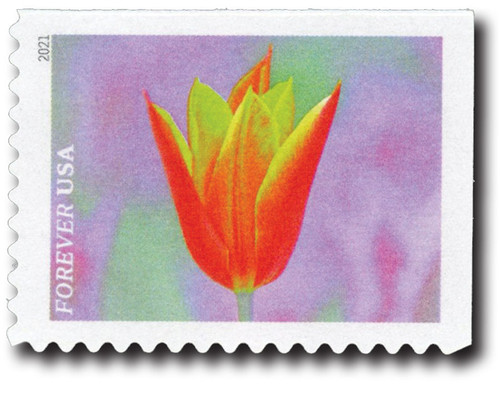
# 5566 - 2021 First-Class Forever Stamps - Garden Beauty: Rose-pink and White Tulip
US #5566
2021 Rose Pink and White Tulip – Garden Beauty
- Pictures a rose pink and white tulip
- Part of the 10-stamp Garden Beauty set
Stamp Category: Definitive
Set: Garden Beauty
Value: 55¢ First Class Mail Rate (Forever)
First Day of Issue: February 23, 2021
First Day City: Bloomfield, Indiana
Quantity Issued: 600,000,000
Printed by: Banknote Corporation of America
Printing Method: Offset
Format: Booklets of 20
Tagging: Phosphor tagged paper, block tag
Why the stamp was issued: To celebrate America’s love of flowers and gardens.
About the stamp design: Pictures an image of a rose pink and white tulip taken by photographer Allen Rokach.
First Day City: First Day of Issue Ceremony held in Bloomfield, Indiana.
About the Garden Beauty set: Includes 10 different stamp designs picturing flowers from America’s gardens. Two flowers (tulips and moth orchid) are pictured twice.
History the stamp represents: Tulips are one of the most commonly planted springtime flowers with an interesting, little-known history. For example, they were first found growing wild from Southern Europe and North Africa to the Middle East and Central Asia. In fact, the name “tulip” is said to have come from the Persian word for turban due to the unusual shape of the flowers.
The first tulips to be cultivated were grown on the steppes and valleys of the Tian Shan Mountains. From there, they made their way to Persia and the people of Constantinople grew them as early as 1055 AD. Once brought to Europe, the popularity of the flower took off, resulting in “tulip mania” in the Netherlands during the 17th century.
Tulips were originally only found in a single color per plant. This changed as vast quantities began being grown at once. Suddenly, an infection in the bulbs of the plants appeared, producing a variegated blossom. This multi-colored tulip was even more sought after, and soon, the virus was intentionally introduced to more plants.
Today, tulips are a sure sign that spring is on its way. They are easy to grow and can be found in countless gardens across the world. However, some of the most impressive displays can still be found in the Netherlands, where tulip mania has never truly left.
US #5566
2021 Rose Pink and White Tulip – Garden Beauty
- Pictures a rose pink and white tulip
- Part of the 10-stamp Garden Beauty set
Stamp Category: Definitive
Set: Garden Beauty
Value: 55¢ First Class Mail Rate (Forever)
First Day of Issue: February 23, 2021
First Day City: Bloomfield, Indiana
Quantity Issued: 600,000,000
Printed by: Banknote Corporation of America
Printing Method: Offset
Format: Booklets of 20
Tagging: Phosphor tagged paper, block tag
Why the stamp was issued: To celebrate America’s love of flowers and gardens.
About the stamp design: Pictures an image of a rose pink and white tulip taken by photographer Allen Rokach.
First Day City: First Day of Issue Ceremony held in Bloomfield, Indiana.
About the Garden Beauty set: Includes 10 different stamp designs picturing flowers from America’s gardens. Two flowers (tulips and moth orchid) are pictured twice.
History the stamp represents: Tulips are one of the most commonly planted springtime flowers with an interesting, little-known history. For example, they were first found growing wild from Southern Europe and North Africa to the Middle East and Central Asia. In fact, the name “tulip” is said to have come from the Persian word for turban due to the unusual shape of the flowers.
The first tulips to be cultivated were grown on the steppes and valleys of the Tian Shan Mountains. From there, they made their way to Persia and the people of Constantinople grew them as early as 1055 AD. Once brought to Europe, the popularity of the flower took off, resulting in “tulip mania” in the Netherlands during the 17th century.
Tulips were originally only found in a single color per plant. This changed as vast quantities began being grown at once. Suddenly, an infection in the bulbs of the plants appeared, producing a variegated blossom. This multi-colored tulip was even more sought after, and soon, the virus was intentionally introduced to more plants.
Today, tulips are a sure sign that spring is on its way. They are easy to grow and can be found in countless gardens across the world. However, some of the most impressive displays can still be found in the Netherlands, where tulip mania has never truly left.













